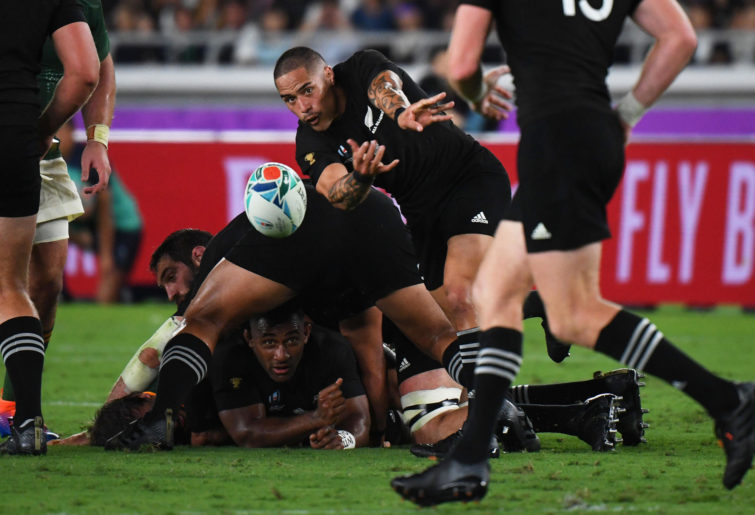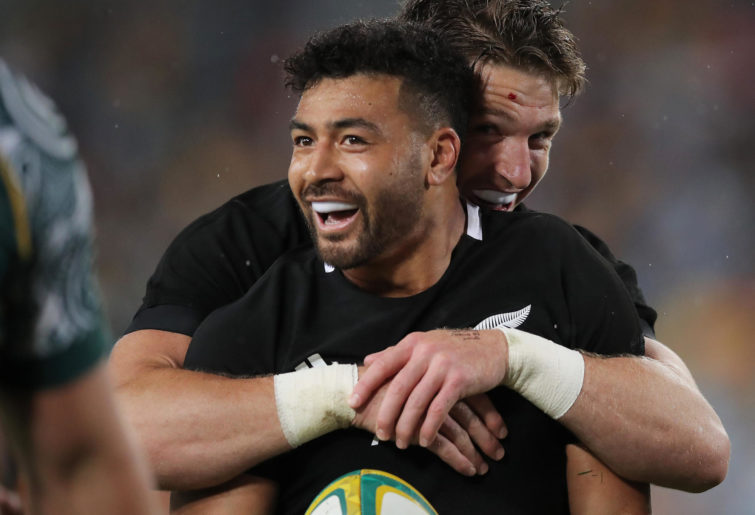This New Zealand win was built, not only on some much-required changes in personnel, but also in how the All Blacks went about their work in front of 70,000 home fans.
Breaking down the component parts revealed serious change to how this New Zealand side went about its business in comparison to the last two seasons.
Halfback
Did anyone notice that Aaron Smith did not kick the ball once, no slow down caterpillar rucks allowing the opposition to reset, no 50/50 challenges in the air in the middle of the park where South Africa have been so strong, and none of the needless surrendering of possession when keeping the ball in hand was a better option.
This tactic was better supported by the structure of and ownership of the backline behind him and we will explore this further.
In addition, he added a minor but critical element to his game before passing. The small step away from the ruck that he employed on many occasions held not only the South African loose forwards in place, but also meant the backline rush defence had to hold for that split second before flying up looking for a target.
The All Blacks repeatedly got to the edge of the Bokke defence and while much of that was driven off the inside backs, they were given a huge head start by the rapid service from Smith and a defence on its heels for split second longer than it would have liked.
That little lateral step fixing the first defender had no better example than when Smith put Caleb Clarke straight through the Boks narrow channel defence for the big break out that ended with the opening score for Sam Cane.
Watch from 2.47 for the Smith set up and through to 3.48 for the Sam Cane score, note how many times Cane is involved in the build-up.
Worth mentioning again something I have raised before, having a first five in Beauden Barrett, who plays constantly flat and takes the ball to the line himself negates much of the advantage New Zealand get by having the worlds best passer of a rugby ball in the side as he takes the time and space generated away by taking tackles too often.
They are quite simply uncomplimentary styles.
Perhaps the best example of this pace of pass and depth came off a lineout in the 15th minute, Smith goes wide and flat to Richie Mo’unga who rips a cutout to the outside shoulder of Rieko Ioane who is away outside his opposite and through the line.
Simple speed of hands combined with depth in the attack and the rush defence of the home side was defeated. We will return to the reactivation of Ioane’s attacking game in this match.

(Kazuhiro Nogi/AFP/Getty Images)
Loose forwards
When the first squad for the season was announced with two true number eights included and then Scott Barrett was named at six for the opening test against Ireland it appeared that coach Foster had finally shelved his failed search for extra run metres via a wider ranging player in the blindside slot.
It took a single injury for him to revert to his previous structure and three losses on the bounce resulted from repeated poor ruck defence and a totally ineffective breakdown.
The selection of Shannon Frizell was a long overdue correction to his two-year long tactical misstep.
Not only did the burden of the work in the tight get shared off the shoulders of Captain Sam Cane but the basics of the game were immediately enhanced.
Clean exits were based on Frizell driving a hard carry off his own line, New Zealand had an extra tackler on the opposition big ball runners and the balance of the trio was transformed to such an extent that the hiding New Zealand got at the breakdown the previous week was overturned in spectacular fashion.
Note, Frizell’s eight carries for 40 metres were straight into the tough stuff all day.
The bigger bonus of this change will be freeing up Sam Cane to play his full game.
The latter Hansen years and the Foster era pigeonholed Cane as the team workhorse and while it is something he excels at, an often-missed fact is the Cane try scoring strike rate.
It is up there amongst the world’s best at just under 20% despite the role he has been asked to play in the last few seasons.
How good was it to see him putting Will Jordan away down the right, recovering a loose ball and in the same phases of attack be the guy who goes over in the corner for the opening score. $6.35 anytime try scorer, thank you very much.
And for those who ad nauseum comment on his form, and admittedly he still below his absolute best, rewatch the first 40 minutes and see where the constant flow of quick ruck ball came from for his side.
The lock forwards
Its not often you seen the much vaunted South African second row given a seeing to around the park but that was exactly what happened in Johannesburg.
Sam Whitelock was back to his best at core roles, and his running of the lineout was excellent with a couple of excellent turnovers to boot, but on rewatching, the influence and slight change in emphasis for Scott Barrett was immense.
Good in his core duties but he was hard at the breakdown on attack and defence, close to ball all day and constantly put pressure on the South African halfback who was forced in kicking errors we do not normally see from a Springbok side.
Barrett’s was an absolute top-drawer effort and Brodie Retallick is going to need a serious step up to get his shirt back.

(Photo by Ian Hitchcock/Getty Images)
First five eighth
And herein lies the primary solution to the All Blacks change of fortune.
Have no doubt, on Saturday this was Richie Mo’unga’s team, he ran the show, and everything went through him.
As well as taking over the goal kicking, he was the go-to guy on the team exits and he stayed in that 10 slot making himself available all day, defending his channel with real vigour.
An offensive cleanout in the run up the opening try and one belting tackle on his opposite further showed the completeness of his performance.
Not often a South African side gets taken for four tries on their home turf, but Mo’unga found multiple ways of not only breaking up, but in the end, stopping the South African rush defence, while winning the tactical and territorial kicking battle.
With ball in hand he showed the courage to hold the ball for that extra second to allow the defence to overcommit, from that clever double pump that put Caleb Clarke away on a first half burst, to running and fixing two South African defenders before putting Reiko Ioane away down the left wing for that burst that reminded us all what he can do to an opposition given time and space, and that move of course resulted in the David Havili go ahead try.
Let’s dwell on the Rieko Ioane game for a second. Its fair to say he never going to be the natural midfield defender needed at this level – watch how he overcommitted in the run up to Lukhanyo Am try for a further example, but what has been most disappointing over the last seven games, has been that he has been a virtual non-entity from an attacking sense, but all that changed on Saturday.
Mo’unga’s depth of positioning and speed of pass, and interestingly almost always when putting Rieko away on the left-hand side of the field, was the catalyst for an attacking display back to his very best, and it was great to see.
Ioane really took the opportunity afforded to him and looked a totally different player to the one who has struggled through the last twelve months.
There is a not an international side in the world that wants to face a Rieko Ioane, ball in hand and with time and space.
I had genuinely forgotten how quick he is given it as so long since that back line has freed him up. He looked perfectly at home back wide on the left and let’s hope he and his coach see that as the way forward.
Richie Mo’unga brought control and direction to that team, something that has been seriously lacking during the All Blacks horror run of losses, and this was tangibly demonstrated in the second half of this match when he, with aid from David Havili and Jordie Barrett, he turned a 40 percent possession stat into a 60 percent territory win.
It’s been a long time since a New Zealand side has managed to do that.
His game numbers of 21 passes and 10 kicks off a total of 50 percent total game possession showed just how much he was at the heart of everything that happened for the All Blacks.
Worth noting here also how much better David Havili looks as a player when given time and space from his inside partner.
The key match difference in Johannesburg was that New Zealand kicked off 10, and South Africa kicked off 9, both with 10 kicks each, and the All Blacks came out on top, with Pollard surprisingly mute.
Being given your first start of the year, away to South Africa at Ellis Park, at the helm of a team on a 3-match losing streak looked like all sorts of a poison chalice when the side was announced, especially with the relative experience of the front row he was playing behind, but he delivered the most controlled performance from an All Black 10 for two years.
Defusing the high ball and the ball and the structure in the back field
Three things made a huge difference here.
One was just the straight quality of the catching, Jordie Barrett and Will Jordan should be commended.
Secondly was their positioning, because Richie Mo’unga spends the way less time in the back field than Beauden Barrett there was a strong sense of ownership and organisation between the two catchers and the All Blacks looked so much better for it.
Thirdly, and critically, because Richie Mounga was winning the kicking and territorial battle against his opposite the South African bombs and box kicks were coming from further back in their own territory and by my count only a single kick landed deep in the New Zealand 22 to be defused.

(Photo by Matt King/Getty Images)
The rest of the time the contests were on the All Black 22 and 10 metre line, with three box kicks actually coming down inside South Africa’s own territory, meaning the visitors catchers were coming a lot further forward before making those challenges in the air.
The constant turning around of those big South African forwards via the tactical kicking game, also played a part in dropping some fatigue into the side, which saw the All Blacks finish over the top of their opposition for the first time in two seasons, just like the good old days.
Buried deep inside this excellent All Black win were some subtle and overt tactical and personnel changes that the coaching team, while enacting them too late to redeem the season, should be congratulated for. Sadly, it will be lost in the noise around the pending Head Coach decision for which this performance may have come too late, as good as it was, to engender the required confidence that a permanent shift has been made.
